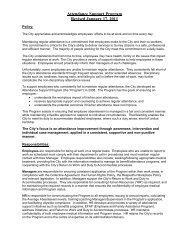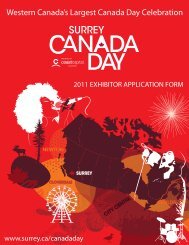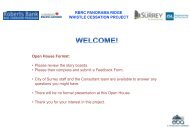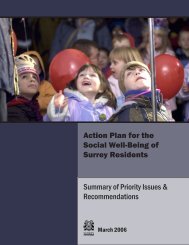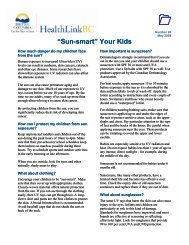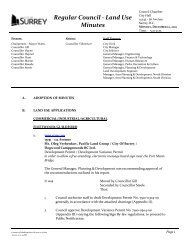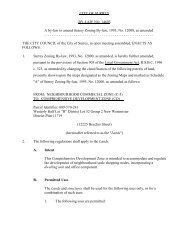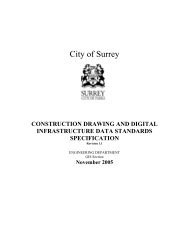Blackie Spit Park: Wildlife Habitat Enhancement Plan - City of Surrey
Blackie Spit Park: Wildlife Habitat Enhancement Plan - City of Surrey
Blackie Spit Park: Wildlife Habitat Enhancement Plan - City of Surrey
Create successful ePaper yourself
Turn your PDF publications into a flip-book with our unique Google optimized e-Paper software.
MANAGEMENT<br />
UNIT<br />
8. Deciduous<br />
Forest<br />
9. Seral<br />
Grassland<br />
10. Dune,<br />
Grassland,<br />
Seral Shrub<br />
WILDLIFE/HABITAT<br />
GOALS<br />
Diversity <strong>of</strong> species<br />
associated with mixed<br />
deciduous-coniferous<br />
forest: terrestrial<br />
amphibians; raptors,<br />
woodpeckers, flycatchers,<br />
wrens, thrushes, vireos,<br />
warblers, grosbeaks,<br />
sparrows; small<br />
mammals; cottontails,<br />
raccoons.<br />
Woodpeckers, passerines,<br />
small mammals<br />
Dune and grassland<br />
vegetation as cover for<br />
cottontails, sparrows,<br />
finches, and other wildlife<br />
Seral shrub land as<br />
habitat for sparrows, and<br />
small resident passerines<br />
(e.g downy woodpeckers,<br />
chickadees, bushtits)<br />
HABITAT MANAGEMENT OBJECTIVES<br />
• Maintain existing deciduous forest development and<br />
plant additional trees along west side and in area south<br />
<strong>of</strong> current grove;<br />
• <strong>Plan</strong>t small number <strong>of</strong> coniferous trees (10) for winter<br />
and nesting cover;<br />
• Do amphibian inventory to determine whether present<br />
in forest or whether introductions are appropriate;<br />
• Manage forest for amphibian habitat features (e.g.<br />
coarse woody debris), if required;<br />
• Control invasive species (e.g., blackberry, broom,<br />
tansey) in peripheral areas between forest edge and<br />
grasslands <strong>of</strong> MUs 10, 11, and 12, at the south end,<br />
and in the northwest where wetland and meadow are to<br />
be maintained (next bullet);<br />
• maintain cattail wetland and open meadow in vicinity<br />
<strong>of</strong> wetland through removal <strong>of</strong> all woody vegetation.<br />
• Decommission all un<strong>of</strong>ficial trails;<br />
• Construct one main trail through the site.<br />
• Remove all broom and blackberry;<br />
• Maintain a ground cover ratio <strong>of</strong> 30% native shrubs<br />
and trees interspersed among the grasses and forbs by<br />
controlling <strong>of</strong> natural succession <strong>of</strong> woody vegetation;<br />
• As part <strong>of</strong> the above, plant native trees and shrubs to<br />
create a connectivity <strong>of</strong> woody vegetation between<br />
MU9 and MU14.<br />
• Permit dune vegetation community <strong>of</strong> existing<br />
introduced grass species to remain;<br />
• <strong>Plan</strong>t native dune vegetation species wherever/-<br />
whenever revegetation is required;<br />
• Continue to remove invasive woody vegetation, both<br />
introduced (e.g. broom, blackberry, knotweed) and<br />
native in dune areas;<br />
• Include information on dune vegetation and<br />
ecosystems, and dune management in <strong>Blackie</strong> <strong>Spit</strong><br />
literature;<br />
• Manage invasive species areas between dune and forest<br />
as a transitional seral habitat by controlling invasive<br />
species and planting native shrubs and small trees;<br />
• Exclude this MU from dog-<strong>of</strong>f-leash area.<br />
<strong>Blackie</strong> <strong>Spit</strong> <strong>Park</strong>: <strong>Wildlife</strong> <strong>Habitat</strong> <strong>Enhancement</strong> <strong>Plan</strong> – PART 1: Background and Summary 11





